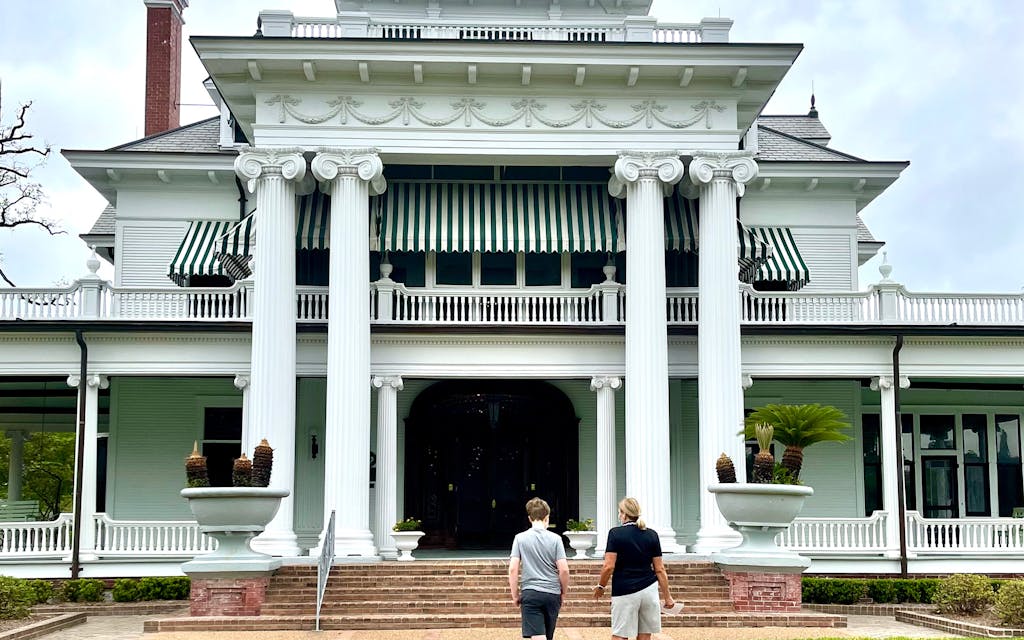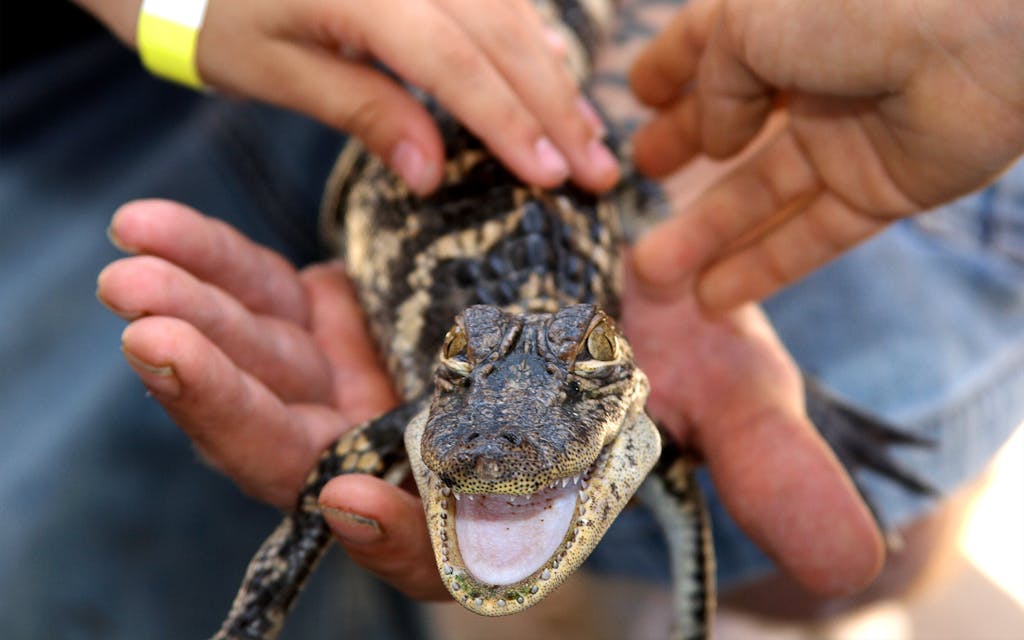Beaumont doesn’t always get a lot of love from the rest of the state. And that’s just not fair. Located only thirty miles west of the Louisiana border and less than an hour-and-a-half drive from Houston, the second-largest city in southeast Texas is often thought of as a pit stop on the way to New Orleans, but local boosters and business owners are hoping to change that. Along with its rich Cajun culture, Beaumont has a thriving restaurant scene, alligator sanctuaries, and museums that rival institutions in much bigger cities.
Settled in 1824, Beaumont has had many lives: it was an early cattle-ranching area, a lumber town, and the site of the 1901 Lucas oil gusher. Revisit the area’s early history at the Spindletop–Gladys City Boomtown museum, with its replica oil derrick that reenacts the spewing of the gusher. For a glimpse of a more genteel side of the city in its boom years, you can tour the McFaddin-Ward House museum and other mansions that once belonged to wealthy families.
If Cajun cuisine, world-class art, and the chance to hold a baby alligator aren’t enough to entice visitors to give this long-overlooked city a chance, the Beaumont area has some of the country’s best birdwatching sites and hundreds of thousands of acres of protected shoreline, forests, and bayous to explore. It’s definitely worth a real visit, not just a bathroom break.
As a native southeast Texan, I have a deep attachment to the region, but I hadn’t spent much time in Beaumont in the decades since I moved to Austin. My teenage daughter and I drove down for the weekend to sightsee, spend time in nature, and check out some newer restaurants. Though many of the places I remember going to with my family (RIP Don’s Seafood) are long gone, Beaumont still has some old favorites, including Rao’s Bakery and Zummo Meat Company, which has been making boudin and smoked sausage since 1908. There are also newer spots that would be right at home in a bigger city; you can find craft breweries and places that serve Korean bulgogi, boba tea, Mexican raisin and vanilla paletas, and birria tacos.
Our plan to head straight to Cattail Marsh, a wetland preserve and bird sanctuary not far from our hotel, was scuttled by a thunderstorm, but the weather cleared in time for us to check out Amelia Farm and Market’s Friday whole-pig roast. A 1916 former fig farm turned working pecan farm, Amelia has a pastoral setting that makes it feel far from town, but it was only a fifteen-minute drive from our hotel. We feasted on pork tacos that were a steal at just one dollar each. Sided with a tangy, pickled red-cabbage slaw and a choice of several house-made salsas, they were some of the best bites I’ve had in ages. Go for dinner, when you can watch the sun set over the farm.
The next morning, after grabbing coffee and pastries at Rao’s, an 81-year old bakery in Old Town, we headed to Collier’s Ferry Park to catch the Ivory Bill, a covered pontoon boat that provides naturalist-guided tours of the Neches River. Southeast Texas is awash in natural wonders, including the Big Thicket National Preserve. The ecologically rich, 108,000-acre park was declared the first national preserve in the U.S. in 1974 after fifty years of work by conservationists to save the area from logging. Known as the “biological crossroads of North America,” it is laced with hiking and paddling trails. Beaumont is also located on both the Central and Mississippi Flyways and is home to hundreds of species of migratory birds, including roseate spoonbills, white ibises, and even the occasional bald eagle. Birdwatchers flock to the area, especially during prime migration season from March to April.
On this surprisingly cool June morning on the edge of the Big Thicket, we saw lots of egrets and a few rarer black-crowned night herons, and as the Ivory Bill plied the shallow waters of a secluded cypress-tupelo swamp, our guide pointed out spider lilies and swamp mallows blooming on the banks.
The two-hour tour finished with a quick spin through the busy Port of Beaumont, which is still recovering from Hurricane Harvey and other recent storms. After we disembarked, my daughter and I were starved and ready for some indoor enrichment. We popped into Katharine & Company, a lunch spot located in the Mildred Building, an arcaded national historic site that was built in 1929 by a Beaumont oil tycoon and named for his daughter. The cafe’s high ceilings, big windows, and fanciful trompe l’oeil murals were charming, and the watermelon gazpacho, chicken salad sandwich, and citrusy avocado salad were perfection. There are also several appealing boutiques and shops in the Mildred; we waited out another rainstorm in Down to Earth, a natural soap and herbal remedy emporium with an upstairs crystal shop that captivated my daughter.

Our next stop was the McFaddin-Ward House, a meticulously restored Beaux-Arts Colonial mansion with much of its original furnishings that was built between 1905 and 1906, in the wake of the Spindletop oil boom. Admission is free, and because we missed the guided tour, we were the only ones wandering through the lovely main house, carriage house, and staff quarters. We spent an hour looking around and were able to imagine life in the glory days of oil-rich Beaumont.
After a bubble-waffle sundae at Cha Cha Cafe, we headed downtown to the museum district to see some murals and historic architecture, including the old Jefferson Theatre and the St. Anthony Cathedral Basilica, and visit the Art Museum of Southeast Texas. Founded in 1950, this regionally focused museum has a formidable permanent collection showcasing the work of southeast Texas luminaries such as Robert Rauschenberg and David Cargill. Local artists often incorporate the region’s natural wonders into their work. One of the temporary exhibits, which runs until August 14, was “Kevin Clay: Sleep Among the Trees,” a collection of moody charcoal abstracts that re-create southeast Texas tree lines from the artist’s memories of his childhood. Haunting images of bayous from Beaumont photographer Keith Carter’s upcoming book, Ghostlight (UT Press, December), will be on display at the Dishman Art Museum in September. Ines Alvidres, a Beaumont artist whose work appears all over town—in restaurant murals, on picnic tables at Cattail Marsh, and even on utility boxes—often incorporates great blue herons, alligators, and local flora into her work.
The weekend flew by, and there was still more art and nature to be seen. We never did make it to Cattail Marsh, but I know I’ll be back, and not just on my way to New Orleans.
Dine + Drink
Get a coffee and pastry at Rao’s, an 81-year-old family-owned bakery that’s known for its Mardi Gras king cake.
Beaumont barbecue is legendary for its all-beef links, a tradition that’s been honed for over a century at Patillo’s Barbecue. At Charlie’s Bar-B-Que (a 2021 Top 50 honorable mention), owner Charles Brewer makes beef links from his grandfather’s recipe, and his wife, Sheila, makes desserts such as sweet potato pie.
The 2021 Top 50 honoree and relative newcomer 1701 Barbecue serves Central Texas–style brisket and ribs right across the street from where the old Pig Stand—a Beaumont icon—was located. Be sure to check out the mural on the side of the new building.
Another colorful mural, this one of a crawfish playing an accordion, adorns the walls of Crazy Cajun, a good spot for po’boys and gumbo. Floyds Seafood, in the old Don’s location, serves everything from its signature gumbos to court bouillon.
JWilson’s, a popular place known for its oyster nachos and “Man Candy,” (slow-smoked pork belly tossed in habanero jelly) has a solid menu and a convivial bar scene.
Beaumont’s first craft brewery, Pour Brothers, has a wide selection of beers on tap, and its large biergarten welcomes kids and dogs and hosts events such as yoga classes, movie nights, and the monthly Boomtown Market.
Started on Kickstarter, Struggle Street Brewing is a downtown spot with a rotating menu of flavors such as Caramel Apple StruggleTart, Blueberry Muffin StruggleStout, and PB&J StruggleTart.

See + Do
Located on the Lamar University campus, the Dishman Art Museum is also a teaching facility and features student work as well as that of artists in residence. It also boasts an impressive collection of tribal art and works by Matisse, Miró, and Kandinsky. Always free.
You can’t go to southeast Texas without having an alligator sighting. Gator Country Adventure Park is home to more than 450 American alligators and other reptiles. This sanctuary and teaching facility offers live feedings, animal encounters, and swamp boat tours. Say hello to 91-year-old Big Al and to Big Tex, reportedly the largest gator ever captured alive at over thirteen feet long.
A crown jewel of Beaumont, Tyrrell Park has recently restored its original visitor’s center and horse stables, both built by the Civilian Conservation Corps in the thirties, to their former glory. The five-hundred-acre park contains a botanical garden, the Warren Loose Conservatory, Cattail Marsh, a golf course, and an extensive trail system for walking or horseback riding ($50 to ride a horse for one hour).
Stay
The MCM Eleganté has comfortable rooms, a lushly landscaped pool, and a Starbucks kiosk in the lobby.
The Days Inn by Wyndham is a newer option with spacious rooms.
This Airbnb cottage is in one of the city’s older, tree-lined neighborhoods yet close to most attractions.

